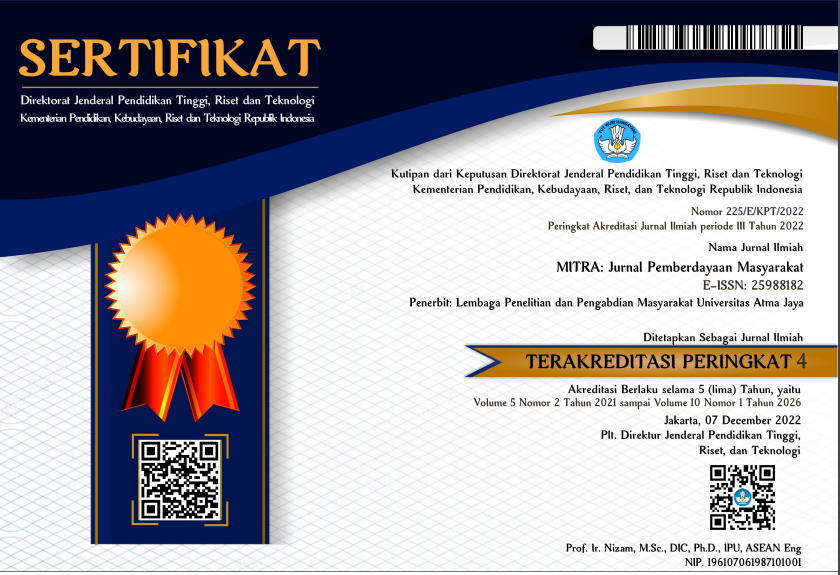Rational Antibiotic Use by Ordinary People in Jakarta
DOI:
https://doi.org/10.25170/mitra.v3i1.502Keywords:
antibiotic, Jakarta, resistance, self-medicationAbstract
Self-medication is defined as self treatment and self-diagnose for conditions such as cough, flu, fever, pain, stomach ulcers, worms, diarrhea, rash, and some other minor illnesses. Based on the data from Badan Penelitian dan Pengembangan Kesehatan Kementerian Kesehatan RI (2013), there were 103.860 of 294.959 households (35,2%) in Indonesia which store medicines for selfmedication (including 35,7% “Obat Keras” or “Gevaarlijk” and 27,8% antibiotics). DKI Jakarta (56,4%) is the highest province with respect to stored medicines. Some studies have found that 40-62% of antibiotics are not used properly. The inappropriate use of antibiotics can lead to antibiotic resistance risk and can be life-threatening for people in every part of the world. To address this problem, this community service was conducted to provide information about selfmedication of influenza and cough illness and to improve people’s knowledge in the proper use of antibiotics. Lecturing was chosen as the method for explaining the rational use of antibiotics and participants were requested to fill out a questionnaire. This activity was attended by 34 participants (and 32 participants filled out the questionnaire). About 13 participants (40,6%) provided correct answers to questions on the proper use of antibiotics. Twenty six participants (81,25%) said they had previously used antibiotics, 14 of them (53,85%) admitted to purchasing antibiotics without a prescription. Antibiotics are taken to treat symptoms such as runny nose, cough, sore throat, fever, and other conditions. A total of 7 participants (26,92%) admitted taking antibiotics with dosage modification and 8 participants (30,77%) switched one type of antibiotics with another type of antibiotics. Based on the results, we concluded that people did not have sufficient knowledge about the rational use of antibiotics. We suggested that counseling about the proper use of antibiotics should be improved.
References
Center for Disease Control and Prevention (CDC). (2013). Antibiotic resistance threats in the United States. United States: U.S. Departement of Health and Human Services, CDC, 2013
Direktorat Bina Farmasi Komunitas dan Klinik, Ditjen Bina Kefarmasian dan Alat Kesehatan. (2007). Pedoman penggunaan obat bebas dan bebas terbatas. Jakarta: Departemen Kesehatan RI.
Izadpanah & Khalili. (2015). Antibiotic regimens for treatment of infections due to multidrug-resistant Gram-negative pathogens: an evidance-based literature review. J Res Pharm Pract, Jul-Sep, 4(3), 105--114.
Kementerian Kesehatan Republik Indonesia (Kemenkes RI). (2011). Modul penggunaan obat rasional. Jakarta: Kementeriaan Kesehatan RI.
Kementerian Kesehatan Republik Indonesia (Kemenkes RI). (2013). Pedoman umum penggunaan antibiotika. Jakarta: Kementerian Kesehatan RI.
Zang L, Huang Y, Zhou Y, Buckley T, & Wang HH. (2013). Antibiotic administration routes significantly influence the levels of antibiotic resistance in the gut microbiota, Antimicrob Agents Chemother, 57(8),3659--3666.
Downloads
Published
Issue
Section
License
This license allows reusers to distribute, remix, adapt, and build upon the material in any medium or format for noncommercial purposes only, and only so long as attribution is given to the creator. If you remix, adapt, or build upon the material, you must license the modified material under identical terms.



_.jpeg)

.png)
2.png)
.png)
.png)



